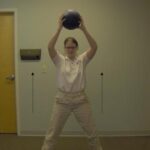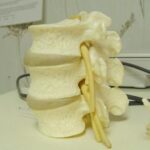The spine is a complex part of the body that has both bone and soft tissue. Even slight misalignment of either bone or tissue can cause pain and a restricted range of motion. This is because the sciatic nerve runs from the lumbar region of the spine (lower back) and then branches down each leg all the way to each foot. Pressure on this nerve may cause pain; loss of reflex in the legs; numbness in the buttocks, legs and/or feet; and limited range of motion due to pain.
The soft tissue that sits between each vertebra of the spine is called a disc. They function as shock absorbers. As a person ages, the quality and durability of discs decreases. However, this process of degeneration can be sped up by improper body mechanics (lifting with the back rather than legs, rough sports, etc.) and trauma. Car accidents or other events that cause unusual stress to the back can cause a disc to bulge, slip or herniate.
A bulging disc means that the disc is protruding from its normal region, which is between two vertebrae. Discs can bulge laterally (side-to-side) or coronally (front-to-back). It is possible to have different discs bulging in different directions, depending on what caused the condition.
The symptoms of a bulging disc depend on the severity of the bulge, or how much of the disc is protruding from the normal disc placement. The location of the disc also affects the symptoms. Most bulging discs are in the lower back, but they can be in the neck and upper back as well. The pain, range restrictions, numbness and other symptoms of a lower back bulging disc are caused by the disc pressing against the sciatic nerve. Since this nerve covers such a large part of the body it can cause symptoms in areas other than the part that is directly affected.
For instance, a bulging disc could potentially cause numbness in the legs or feet. Or the lower back may be the only region affected. It really depends on where and how the disc (or discs) is pressing on the sciatic nerve.
Treatment of bulging discs is difficult because there isn’t a procedure or drug that corrects the problem. Resting, doing physical therapy, taking anti-inflammatory medication or steroids and avoiding activities that will worsen the condition are essentially the only available treatments. People with bulging discs need to be patient and allow the body to heal.
One peril of using anti-inflammatory and steroid medications (steroids are anti-inflammatory, but other medicines may be used as well) is that if the pain and other symptoms resolve a person may damage the disc more by doing activities that put stress on the disc. These medicines only treat the pain; they do not correct the disc. So if you can’t feel the pain when bending, lifting, etc. you may be causing your disc to bulge further or not be able to heal back into place by continuing to do the harmful activities. If you do use any kind of pain medication, keep in mind what activities normally cause you pain and discomfort; continue avoiding them even if you don’t feel the pain. Just remember that the pain is only blocked temporarily by the medication, and that the bulging disc is still injured.
Sources:
Anatomy of Sciatica, http://www.spineuniverse.com/conditions/sciatica/anatomy-sciatica
About Bulging Discs, http://www.laserspineinstitute.com/back_problems/bulging_disc/


